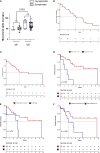Prognosis of hyperviscosity syndrome in newly diagnosed multiple myeloma in modern-era therapy: A real-life study
- PMID: 36569885
- PMCID: PMC9771682
- DOI: 10.3389/fimmu.2022.1069360
Prognosis of hyperviscosity syndrome in newly diagnosed multiple myeloma in modern-era therapy: A real-life study
Abstract
Hyperviscosity syndrome (HVS) is a rare complication of newly diagnosed multiple myeloma (NDMM) related to high tumour burden. Studies about the prognosis of HVS in modern-era therapy for NDMM are missing. We investigated a retrospective cohort study of NDMM with HVS between 2011-2021. Thirty-nine NDMM patients with HVS were included. HVS presentation was heterogeneous, with asymptomatic, mild, and neurological forms in 23%, 59%, and 18% of cases, respectively. No thrombosis or major bleeding was observed. Therapeutic plasma exchanges were used in 92% of patients, which were effective and well tolerated. No rebound effect was observed. All patients except one had at least one CRAB criterion. Most of the patients received bortezomib and high-dose steroids (95%) associated with an immunomodulatory drug (43%) or alkylating agents (42%). HVS in NDMM patients had dismal overall survival matched to multiple myeloma patient controls (without HVS) in our center (median: 3.6 vs. 7.7 years, p=0.01), as confirmed by multivariate analysis. Early deaths (in the first two months) occurred in 21% of older patients (>65 years). HVS in NDMM patients is a rare but life-threatening complication associated with high lethality in older patients and be a potential dismal prognosis factor in the modern treatment era.
Keywords: HVS; TPE; myeloma; neurological; prognosis.
Copyright © 2022 Debureaux, Harel, Parquet, Lemiale, Siguret, Goubeau, Morin, Royer, Cuccuini, Elessa, Theves, Brignier, Azoulay, Arnulf and Talbot.
Conflict of interest statement
AB received support from OCTAPHARMA for attending a meeting. The remaining authors declare that the research was conducted in the absence of any commercial or financial relationships that could be construed as a potential conflict of interest.
Figures




